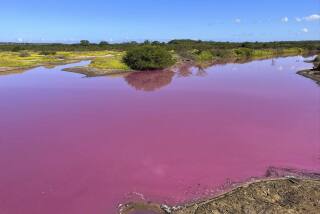Pink Dolphins Far From in the Pink
- Share via
HONG KONG — A flash of bubble-gum pink split the silt-brown seas, cutting a path through disposable lunch boxes and other foul-looking scum bobbing around on top.
“Yes!” Bill Everett, the boat operator, shouted gleefully.
More pink flashed up ahead and Everett beckoned the helmsman to approach a little, very slowly.
Everett, who owns the tourism company Dolphinwatch, has seen Chinese white dolphins in the Pearl River’s brackish waters hundreds of times, but he still gets excited.
So he should. The dolphin, which in Hong Kong is really pink, will soon disappear from the British colony’s waters, killed off by pollution, experts say.
The dolphins, known officially as the Indo-Pacific Humpback or Sousa Chinensis, are also found off South Africa and Australia. They come in three main shades: purple-blue, gray and green. Only in Southeast Asia are they pink, and only in Hong Kong do they assume a bubble-gum hue.
Experts estimate that only 100 to 200 of the pink variety are left in western Hong Kong’s shallow, muddy waters, and their numbers are dropping fast.
So far this year, eight dead dolphins have washed up on the colony’s shores, with photos of their rotting carcasses sometimes appearing in newspapers the next day. Last year, 10 dolphins, between 5% and 10% of their estimated population, were found dead.
Experts say the real annual death rate is probably much higher, perhaps touching 20%, since dolphins’ bodies may sink or float out to sea.
There have been dolphin-sightings in neighboring China’s waters, but not many, said Lyndsay Porter, a dolphin researcher.
New research suggests that the dolphins are being killed by chemicals discharged by China into the Pearl River, which runs through the rapidly industrializing southern Chinese province of Guangdong and flows into the dolphins’ habitat off Hong Kong.
The chemicals include the pesticide DDT, still used in China but banned in many other countries, and toxins used in the production of plastics. They lodge in the dolphins’ body fat and are passed to baby dolphins in their mother’s milk, said Chris Parsons, a marine biologist who has studied the Chinese white for three years.
Autopsies on dolphin carcasses found toxins concentrated at 150 parts per million, as well as high levels of poisonous mercury, lead and cadmium, meaning “the dolphins are basically toxic waste,” Parsons said.
Without radical remedies, the Hong Kong dolphin will be extinct within five years, he said.
“Pollution levels are going to get higher and higher and China needs to soon do something pretty drastic about its environmental pollution,” he said.
Nor is the threat confined to chemicals. Hong Kong’s new multibillion-dollar airport is being built smack in the middle of the dolphins’ habitat, on land reclaimed from the sea off Lantau Island in western Hong Kong.
Dredging, blasting and oil spills during construction are stressing the dolphin and contributing to its rising death rates and falling fertility rates, Parsons said.
The stress factor will probably get worse once the airport opens in 1998, as the sound of jumbo jets taking off and landing wreaks havoc with the sensitive hearing that dolphins use to navigate muddy waters.
Under pressure from conservationists, the government proposed establishing a marine park for the dolphins. But the park will be built around an airport refueling facility and will be so small an adult dolphin could swim its length in four minutes, conservationists say.
Catherine Kan, a Hong Kong government marine conservation officer, says that the government is concerned about the dolphins, but that conservation needs to be balanced against economic growth.
Preserving the dolphin “may be a low priority,” she said.
The dolphin has been chosen as the mascot for ceremonies next year when Hong Kong returns to Chinese sovereignty, but there are no signs yet that this will lead to more efforts to save it from extinction.
Said Everett of Dolphinwatch: “I hope it makes it as far as the transition” on July 1, 1997.
One Japanese tourist aboard his boat added, “I hope this government does something to help it.”
More to Read
Sign up for Essential California
The most important California stories and recommendations in your inbox every morning.
You may occasionally receive promotional content from the Los Angeles Times.













